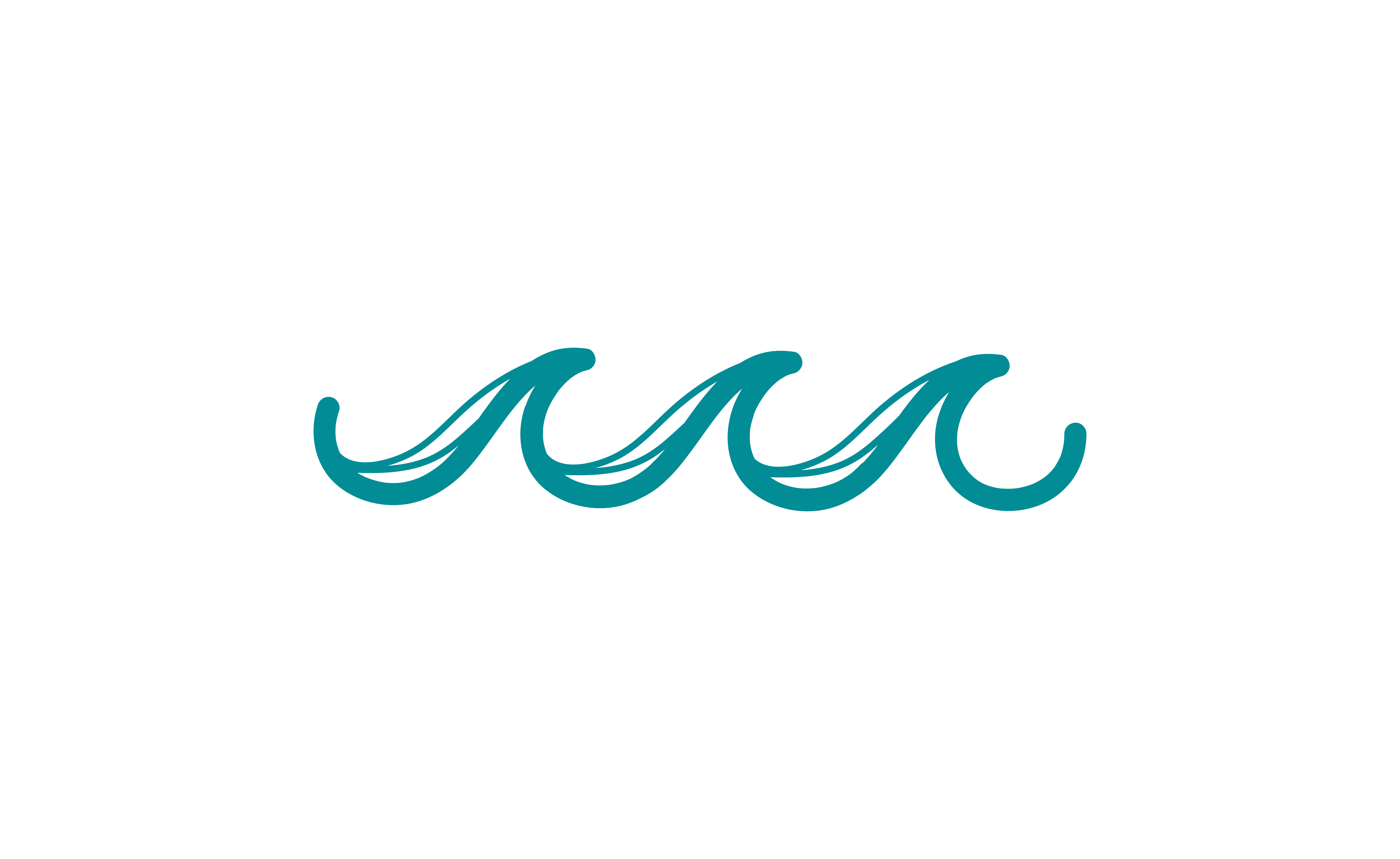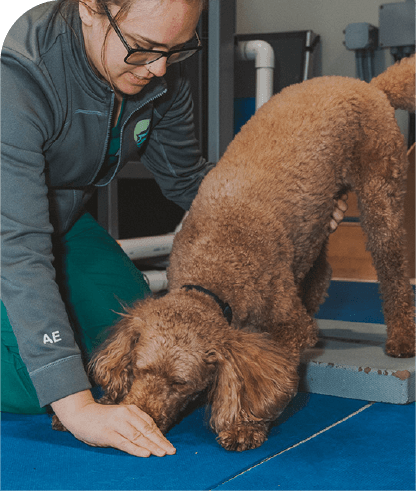Rehabilitation Therapy Treatments
We want to work with you to help your pet heal faster, move quicker and feel better.
You may not yet have a diagnosis or answer to why your pet is lame, sore or in pain. We offer initial examinations to determine the source of the problem. Once we know the issue we are dealing with then a proper and individualized treatment plan can start to take shape.


Rehabilitation therapy treatments for your pet
We welcome the opportunity to work with patients who have been referred from other veterinary clinics, as well as clients who have recognized a need for our services without a prior referral. Some of our most common treatments include:
• Musculoskeletal injuries (iliopsoas, biceps, gracilis, supraspinatus injury)
• Osteoarthritis
• Cruciate ligament injury/rupture
• Hip dysplasia
• Elbow dysplasia
• Lameness
• Intervertebral disc disease (IVDD)
• Back pain
• Joint injury
• Neurological conditions (cauda equina, lumbosacral disease, IVDD, brachial plexus injury etc)
• Performance problems in sport animals
• Weight loss management
Rehabilitation therapy treatments for your pet
We welcome the opportunity to work with patients who have been referred from other veterinary clinics, as well as clients who have recognized a need for our services without a prior referral. Some of our most common treatments include:
• Musculoskeletal injuries (iliopsoas, biceps, gracilis, supraspinatus injury)
• Osteoarthritis
• Cruciate ligament injury/rupture
• Hip dysplasia
• Elbow dysplasia
• Lameness
• Intervertebral disc disease (IVDD)
• Back pain
• Joint injury
• Neurological conditions (cauda equina, lumbosacral disease, IVDD, brachial plexus injury etc)
• Performance problems in sport animals
• Weight loss management
Veterinary Rehabilitation is a therapeutic approach to help relieve pain and dysfunction in animals.
Research proves that every and all patients can benefit from rehab. Dr. Tara Hudye, Dr. Corben Scherer, Dr. Alexina Labrecque and Jillian Clark, PT, are all certified in this field in addition to their veterinary and/or physiotherapy degrees. Each pet will have an unique and individualized treatment plan involving owner education and home management, treatment modalities and therapies to help regain function and relieve pain.
Veterinary Rehabilitation is a therapeutic approach to help relieve pain and dysfunction in animals.
Research proves that every and all patients can benefit from rehab. Dr. Tara Hudye, Dr. Corben Scherer, Dr. Alexina Labrecque and Jillian Clark, PT, are all certified in this field in addition to their veterinary and/or physiotherapy degrees. Each pet will have an unique and individualized treatment plan involving owner education and home management, treatment modalities and therapies to help regain function and relieve pain.
Manual therapy is often thought of as just ‘massaging’. It is so much more than just that! Our hands are used in both assessment and treatment. We need to determine the tone of the muscle, the joint restrictions, and myofascial trigger points. We determine a sense of the grinding of the joints, or crepitus, and can feel the knot within the muscle that is causing pain.
When you first see us place our hands on your pet, you may easily mistake manual therapy for massage. Although massage is an important tool we often use in clinic and also teach owners to do at home, manual therapy is so much more.
Massage uses pressure on the skin and tissue/muscles to increase circulation, flexibility, tension release and relaxation.
Manual therapy techniques can increase the healing process and correct faults within the soft tissues and joints. Learning to do manual therapy is an advanced skill, learned after becoming a certified rehab practitioner/vet and I can attest that it takes years to develop a keen sense of touch that is needed to do a good job. I often will look away, or close my eyes to block out the visual sense in order to focus on my tactile senses. I know I may look awkward, but I swear this helps!
Manual therapy involves a hands on technique that will realign joints and correct positional faults of the tissue. We will utilize soft tissue (fascial and ligament) mobilization, muscle energy techniques, myofascial release, joint mobilizations and manipulations. Why do this all this?
Incredibly, these techniques will increase the range of motion of the joint, meaning we can improve the joints ability to flex or extend. A very important treatment especially in chronic arthritis or strain situations. In addition, by mobilizing or moving a joint is a very specific way, we can upregulate the joint fluid and circulation of the joint. Lastly, manual techniques have the added benefit of pain relief. By eliminating a trigger point, or ridding a muscle spasm, we can drastically make improvements in pain relief and healing rate.
Using manual therapy, massage or both for our patients is just one of the many tools we utilize at our clinic. Each case is individualized; some cases require the manual therapy to be the majority of treatments, while others do not require as much. Nonetheless, our hands are the most effective tool we have to help your pet, both in the assessment and treatment!

Dr. Tara Hudye and Dr. Alexina Labrecque received their needling and acupuncture training through various colleges and affiliates including the Atlantic Veterinary College, College of Integrative Therapy and Canine Rehabilitation Institute. Both doctors perform acupuncture on our patients to increase pain relief, increase healing rate and overall increase the recovery of our patients. Basically, we use acupuncture in any patient we feel would benefit from its healing and pain relieving effects. Most of our patients get very sleepy or even fall asleep during the treatment!
Acupuncture has been used for thousands of years as a way to help treat different ailments. The needles are very small, in fact the dogs and cats rarely detect the needle placement. Specific points or sites are chosen that will result in pain relief, increase muscle and nerve function, and decrease inflammation.
Our patients either receive acupuncture treatments as a sole treatment or often, it is added to our rehabilitation therapy as an added benefit to their recovery program.
Acupuncture can help relieve many problems, such as:
- Arthritis
- Back pain
- IVDD (Intervertebral disc disease)
- Myofascial trigger points and pain
- Elbow and hip dysplasia
- Ligament problems
- Post operative and preoperative care
- Hind end weakness
- Degenerative myelopathy
- Vestibular disease
- Dental pain
- Nerve paralysis (radial nerve, brachial plexus avulsion)
Benefits of acupuncture:
- Increased circulation and decreased inflammation
- Pain relief
- Better joint range of motion and mobility
- Prevention of injury
- Return of muscle function and memory
All of our patients enjoy and benefit from acupuncture. We know we can help your pet as well!

Laser therapy uses light energy to reduce pain, increase metabolic activity, and facilitate healing. The light from the laser is absorbed by the cells within the tissue, which activates cell reproduction and growth. Laser treatments are painless and will increase circulation and stimulate oxygen, nutrients and water content of the body towards the damaged tissue in need of repairing tissue. This will result in optimal healing with decreased muscle stiffness, pain and inflammation.
Benefits of Laser therapy:
- Accelerated tissue repair and cell growth
- Anti-inflammatory
- Enhances wound healing
- Increased nerve function
- Reduced scar tissue
- Enhancing immune cells to combat pathogens
- Drug free solution to pain relief
When can Laser Therapy be used?
- Tendon/ligament injuries
- Arthritis
- Muscle spasms
- Inflammation
- Bladder infection/ cystitis (Feline lower urinary tract disease)
- Ear infection
- Anal gland inflammation (anal sacculitis)
- Post-operative care (incision site healing)
- Wounds
- Swollen joints
- Capsulitis
- Tendonitis
- Burns
- Insect bites
- Fractures
- Hot spots
Electrical stimulation is the application of electrical impulses to muscles, stimulating contractions. It aids in pain management and prevents muscle atrophy (muscle loss).
Neuromuscular electrical stimulation (NMES) stimulates a target muscle or tissue using nerves. We will use this mode of therapy in cases where muscle loss is significant or nerve function is impaired, such as nerve paralysis patients or post operative patients.
Transcutaneous electrical nerve stimulation (TENS) is a form of NMES and is mainly used to help alleviate pain or muscle spasms. Our first and foremost goal of all patients is pain control. We utilize TENS in many of our patients to give immediate pain relief. In many cases of chronic back pain and spondylosis patients, we teach owners how to use the machine at home so pain control can be managed at a constant level.
With advancements in technology, we are able to use the body's own cells to heal and regenerate damaged tissue in a way that other medical and surgical techniques may not be able to.
Platelet Rich Plasma (PRP)
Platelets are a blood cell naturally found in the body and are important in wound healing and blood clotting. Platelets have two types of granules. In PRP therapy, we are interested in the granules responsible for wound healing and the growth factors. It is these growth factors that will stimulate other body cells to migrate to the injured area and start tissue healing. Platelets will also recruit and activate stem cells. This is all very important in the healing of tissue, cartilage, muscle, soft tissue, tendon, skin and ligament.
Stem Cells (Bone Marrow Derived)
Once the bone marrow is collected and processed in house from the patients bone, the concentrated stem cells are injected into the damaged joint, tendon or ligament. The stem cells will:
1. Activate surrounding resident cells
2. Release cell factors and growth factors to speed healing and tissue repair
3. Reduce and /or eliminate scar tissue
4. Modulate immune function
5. Differentiate into surrounding tissue type
Injection site discomfort is the most common side effect reported. This typically resolves within 12-24 hours post injection. We will send your pet home with medication to help with this initial discomfort.
Steroids and anti inflammatory medications are avoided immediately pre and post injection to avoid interference with the healing process.
To optimize maximum healing and mobility potential, we always recommend a dedicated conditioning and post op rehab program alongside injection therapy. With every regenerative injection case we perform, follow up exercise therapy along with a home treatment plan and underwater treadmill therapy is included.

Hydrotherapy in an underwater treadmill uses the natural properties of water, or the principles of relative density, buoyancy, hydrostatic pressure, surface tension, viscosity and resistance to achieve its therapeutic benefits in a safe environment. Exercising in water can help reduce fatigue and pressure on joints, soothe muscle strain, and help with balance and body awareness. It can also improve mobility and flexibility, allowing our patients to recover from surgery or an injury quicker and ultimately return to physical activity.
Many conditions benefit from hydrotherapy, especially those disorders in which an animal is reluctant to use a limb or there is a lack of strength, range of motion, proprioceptive (body awareness) ability or weight-bearing status. If the dog will not use their limb on land due to injury or compensation, they will be more apt to use it in the water due to its properties. We also utilize variable controls over the speed, resistance and depth of the water, which allows for a tailored and progressive therapy plan for every type or breed of patient. Furthermore, resistance jets can also be turned on or off, depending on the amount of resistance desired, which is useful for muscle strengthening and cardiovascular training as well as reducing swelling and edema.
PEMF utilizes bursts of low level electromagnetic radiation to decrease pain caused from injury. It will increase the healing of damaged bone, tissue and muscle. This therapy is pain free and can often be prescribed for owners to use at home on a daily basis for chronic conditions. PEMF technology is one of our unique therapies utilized for our rehab and surgical patients to increase pain control.
At our clinic, we utilize the Embrace PEMF systems. Both provide pain relief especially in chronic pain conditions such as arthritis. Ask us if you think your pet could benefit from an at home system that is affordable, easy to use and beneficial to their mobility and quality of life!
Ultrasound waves are produced by synthetic crystals that vibrate at a particular frequency which can then penetrate the skin. We have two types of ultrasounds in our clinic, therapeutic and diagnostic. The therapeutic ultrasound is used as a healing modality in our rehabilitation patients. The therapeutic sound waves are specifically targeted to penetrate the damaged tissue. The waves will reduce pain and inflammation, increase circulation and increase mobility of soft tissues. This will result in expediated healing. Ultrasound therapy can help with a variety of injuries. Please contact us to see if ultrasound therapy is appropriate for your pet.
Common injuries therapeutic ultrasound is used:
- Cruciate tear
- Meniscal damage
- Arthritis
- Sprains and muscle tendinopathies (biceps tendonitis, infraspinatus tendinopathy, supraspinatus tendinopathy)
- Achilles tendon injury

Bodies are made to move, but injury and compensation can prevent this. With our knowledge of tissue repair, movement and kinematics, we will utilize specific movement exercises to strengthen and add flexibility to the spine and joints.
Can you squat? Do yoga? High step? So can your canine friend! With our knowledge and expertise we can teach you tricks to entice your pet to do the same.

Shock wave technology is a noninvasive, high-energy sound wave treatment commonly used in human and veterinary medicine. It helps the body in relieving pain, speeding healing, and improving the quality of healing.
Shock Wave systems have been proven effective for treating such conditions as:
- Tendon and ligament injuries
- Bone fractures (stress fractures/splints)
- OA/Joint inflammation and pain
- Foot Injuries
- Wounds/Lick Granulomas
- Back pain
- Cauda Equina Syndrome (LS disease)

How Does Veterinary Spinal Manipulation Work?
The bones and skeleton provide the support and locomotion that allow muscles, tendons, and ligaments to move the body. The nervous system’s primary pathway for communication within the body runs down the length of the spinal column. So, if the vertebrae or joints move out of proper alignment (become subluxated) due to an injury or other stress, they will impinge the nervous system.
These impingements affect the function of the nervous system and decrease proper circulation. This often results in pain and reduces the brain’s ability to communicate and control the proper function of the rest of the body. Reduced circulation causes inflammation and inhibits the delivery of healing oxygen and nutrients to injuries. This will delay healing.
Spinal manipulation gently restores the proper alignment of the skeletal system, which promotes healthy nervous system function, organ function, immune system response, improved circulation, reduced inflammation, and faster healing.Along with obtaining her CVA (Certificate in Veterinary Acupuncture), Dr.Labrecque is able to use Traditional Chinese Medicine (TCM) to help diagnose and treat our clients. The main principle of TCM is to help regulate the body’s energy source, called Qi (chi). In the presence of disease, Qi can be altered or blocked in the body. Acupuncture uses needles to help clear these blockages and helps to promote the body’s natural balance. TCM acupuncture can help various conditions including arthritis, nerve issues, bladder disease, behavioural problems, liver and gastrointestinal disease.














